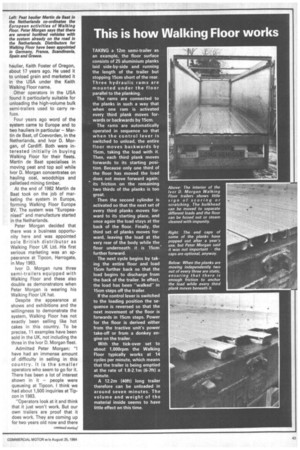This is how Walking Floor works
Page 75

If you've noticed an error in this article please click here to report it so we can fix it.
TAKING a 12m semi-trailer as an example, the floor surface consists of 25 aluminium planks laid side-by-side and running the length of the trailer but stopping 15cm short of the rear. Three hydraulic rams are mounted under the floor parallel to the planking.
The rams are connected to the planks in such a way that when one ram is activated every third plank moves forwards or backwards by 15cm.
The rams are automatically operated in sequence so that when the control lever is switched to unload, the entire floor moves backwards by 15cm, taking the load with it. Then, each third plank moves forwards to its starting position. Because only one third of the floor has moved the load does not move forward again; its friction on the remaining two thirds of the planks is too great.
Then the second cylinder is activated so that the next set of every third planks moves forward to its starting place, and once again the load stays at the back of the floor. Finally, the third set of planks moves forward, leaving the load at the very rear of the body while the floor underneath it is 15cm" further forward.
The next cycle begins by taking the entire floor and load 15cm further back so that the load begins to discharge from the back of the trailer. In effect, the load has been "walked" in 15cm steps off the trailer.
If the control lever is switched to the loading position the sequence is reversed so that the next movement of the floor is forwards in 15cm steps. Power for the floor is derived either from the tractive unit's power take-off or from a donkey engine on the trailer.
With the tick-over set to about 1,000rpm the Walking Floor typically works at 14 cycles per minute, which means that the trailer is being emptied at the rate of 1.8-2.1m (6-7ft) a minute.
A 12.2m (40ft) long trailer therefore can be unloaded in around seven minutes. The volume and weight of the material inside seems to have little effect on this time.












































































































